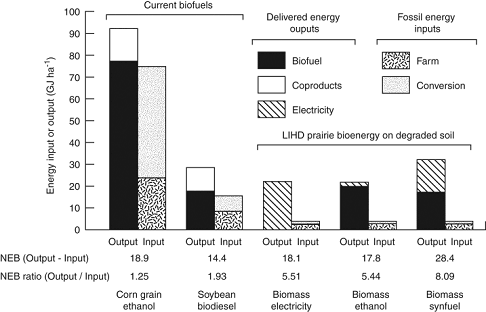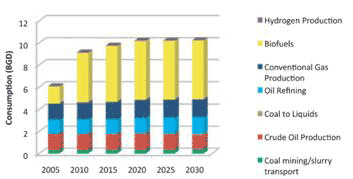Scientific evidence shows most if not all biofuels require more fossil fuel energy to produce and will never be a major green energy option Dr. Mae-Wan Ho
Critics have long charged that when realistic life cycle accounting is done, most biofuels require more fossil fuel energy input to make than the energy contained in the biofuel. In other words, the ratio of energy in the output ethanol to the external energy input is less than 1 (see [1] Biofuels for Oil Addicts, SiS 30).
The US Department of Agriculture (USDA) is a strong advocate for biofuels, and has consistently projected an optimistic picture. In June 2010, USDA produced a revised energy balance for corn ethanol based on new data obtained in the Agricultural Resource Management Survey of corn growers for the year 2005, and the year 2008 survey of dry mill ethanol plants [2]. It found the energy output/input ratio for corn ethanol to be 1.4 without allowing for processing byproduct (such as grain residue for animal feed). After allowing for byproduct, the energy ratio is between 1.9 and 2.3. In other words, there is 40 percent more energy in corn ethanol than the energy used to produce it, if byproduct is not counted, and 90 to 130 percent more if byproduct is counted.
The largest energy components for corn production are nitrogen and direct energy for fuel and electricity. The report stresses the improvements in recent years that make the process more efficient. Nitrogen use has declined by about 20 percent and all direct energy components have declined by about 50 percent since the mid-90s. Together, the nitrogen and direct energy reductions result in a 30 percent drop in energy required to produce a bushel of corn, from 65 285 BTU/bu in 1996 to 41 029 BTU in 2005.
In the past 20 years, ethanol yields from corn have increased by about 10 percent, so proportionately less corn is needed in 2005. Further, as only the starch fraction of the corn plant (66 percent of energy content) is used for ethanol production, the net (34 percent discounted) corn energy used for ethanol production is 9.811 BTU/gal. The energy ratio for corn ethanol is calculated based on this discounted energy value in the corn, giving an overall positive energy balance. If the ratios were based on the undiscounted corn energy value, the ratios would have been 0.92 without byproduct, and 1.23 to 1.51 with byproduct. This is getting closer to what critics are saying, the energy gain is often small, and could be negative.
The new USDA estimates are still unrealistic, as they did not include the energy embodied in building the refinery, or in the water used, or in the disposal of sewage effluent, for example.
David Pimentel at Cornell University in the United States is among the fiercest critics of biofuels, in particular of corn ethanol (see [1]). He points out [3] that in 2008, 9 billion gallons of ethanol were produced from 33 percent of the corn harvest in the US, subsidized at US$ 6-7 billion, to supply just 1.3 percent of the country’s oil consumption. Even if all 341 Mt of corn in the US were to be converted into ethanol, it would provide only 5 percent of the total oil consumption in the country, leaving nothing for livestock feed or food [4].
It takes 2.69 kg of corn grain to produce 1 litre of ethanol. Based on the most recent data available, Pimentel and colleagues showed [4] that 31.292 MJ of energy are consumed in order to produce a litre of ethanol containing 21.1 MJ. The output/input ratio is 0.674. In other words, 48 percent more energy than in the ethanol is consumed in producing it, and at a cost of $1.05 per litre. Of course, if the price of corn increases any further, the cost of producing ethanol would rise sharply, as most of what it costs is in the corn itself.
Ethanol at $1.05 per litre is equivalent to $176 per MWh, making it much more uneconomic than many renewables including biomass (see [5] Renewables Cost Less, SiS 49). Subsidies for corn ethanol at $6-7 billion per year are 60 times that of gasoline, litre for litre.
Pimentel and colleagues’ estimates for soybean biodiesel gave a net loss in energy of 63 percent, at a cost of $1.251 per kg, for rapeseed/canola biodiesel, the net loss of energy is 58 percent, at a cost of $1.52 per kg; for oil palm biodiesel, 8 percent energy loss.
Cellulosic ethanol, the ‘second generation’ biofuel made from non-edible sources of cellulose after it has been broken down into sugar units by enzymes or acid hydrolysis, has been much hyped as not competing with food production. Some of us were far from impressed (see [6] Ethanol from Cellulose Biomass Not Sustainable nor Environmentally Benign, SiS 30). The previous Bush administration put a lot of funding into it, and the US Environmental Protection Agency (EPA) mandated the production of 100 million gallons of next generation biofuels by 2010. Pimentel and Tad Patzek [7] report a negative energy return of 68 percent for switchgrass, the monoculture perennial most favoured by proponents, even worse than corn ethanol, and at a cost of 0.93/litre. Basically, it takes two to five times more cellulosic biomass to achieve the same quantities of sugars as in the corn grain. In addition, the sugar units are tightly held in the lignin of cellulosic biomass, and strong acids must be used to dissolve about 25 percent of the lignin.
In February 2010, the US EPA had to revise its mandate for 100 million gallons of second generation biofuels to be produced for the year drastically downwards by 93.5 percent to just 6.5 million gallons, on account of “technology and financial problems” that cellulosic ethanol producers have been experiencing [8]. One of the leading cellulosic ethanol producers, Cello Energy, was shut down in the summer of 2009 after its founder cheated investors out of millions of dollars by building a fake plant that produced fuel from petroleum sources instead of grass. EPA was banking on Cello to deliver 60 of the 100 million gallons in 2010. Meanwhile other companies using enzymes or acids to break down cellulose are either waiting for funding or are in the early stages of constructing commercial plants. With lower oil prices at around $75 a barrel, cellulosic ethanol companies find it difficult to compete with gasoline.
Can cellulosic biofuels be produced sustainably?
David Tilman and colleagues at the University of Minnesota in the US had suggested that biofuels derived from low-input high diversity (LIHD) native grasslands are much more sustainable than using monoculture crops [9]. Their own research on agriculturally degraded and abandoned nitrogen poor sandy soil has shown that high diversity grasslands had increasingly higher yields that reached 338 percent those of monocultures after a decade (see [10] Biodiverse Systems are More Productive, I-SIS news 13/14). LIHD biofuels are carbon negative [9] because net ecosystem sequestration of of 4.4 tonnes/ha/y of carbon dioxide in soil and roots exceeds fossil carbon dioxide released during biofuel production, estimated at 0.32 tonnes/ha/y.
Moreover, LIHD biofuels can be produced on agriculturally degraded lands, and thus need neither displace food production nor cause loss of biodiversity by destroying habitats. As these plots are unfertilized, they are not expected to emit N2O and would also avoid the warming potentials of current agri-biofuels ([11] Scientists Expose False Carbon Accounting for Biofuels, SiS 49).
The gross yield from LIHD plots was 68.1 GJ/ha/y in biomass energy. Fossil energy required for biomass production, harvest, and transport to a biofuel production facility was estimated at 4.0 GJ/ha/y. Different biofuel production methods capture different proportions of the biomass energy. Co-combustion in existing coal-fired electric generating facilities would provide a net gain of about 18.1 GJ /ha as electricity. Converting into cellulosic ethanol and electricity is estimated at 17.8GJ/ha. Conversion into gasoline and diesel synthuels and electricity via integrated gasification and combined cycle technology with Fisher-Tropsch hydrocarbon synthesis (IGCC-FT) is estimated to give 28.4 GJ /ha.
LIHD biofuels compare very favourably with existing biofuels in energy balance, or output/input ratio (see Fig. 1).

Figure 1 Net energy balance (NEB) for two current biofuels compared with LIHD biofuels
Switchgrass monoculture can be highly productive in fertile soils, especially with application of pesticides and fertilizers. However, on infertile soils, switchgrass monoculture yields were indistinguishable from the monoculture yields of other species at 23+2.4 GJ/ha/y.
Attractive as this may seem, the identification of ‘abandoned or degraded agricultural land’ is beset with uncertainty. Such land is known to be used by local people foraging for fuel wood and wild foods. A study published in 2008 estimated global ‘abandoned’ agricultural land to be between 385-472 million hectares, with average productivity of 4.3 tonnes/ha/y. This would satisfy less than 10 percent of primary energy demand for most nations in North America, Europe, and Asia [12]; but it could represent many times the energy needs of some African nations where grasslands are relatively productive and current energy demand low. It is important to ensure that local communities are involved, and their livelihoods guaranteed in any proposal to grow bioenergy crops in abandoned agricultural land.
However favourable the energy and carbon balances, and even with the appropriate audit in place to safeguard social and environmental sustainability (see [13] Biofuels and World Hunger, SiS 49), biomass energy will never be a major solution, especially for a heavy energy user like the US.
Each year, the US uses three times as much as the total solar energy of 34.288 EJ (1015J) captured by all harvested crops, forests and grasses. There is simply not enough biomass in the whole of the US to produce biodiesel and ethanol to make the country independent of oil. The US currently imports 63 percent of its oil.
A potentially more serious constraint is water. Deborah Elcock at Argonne National Laboratory, Washington D.C. combines projections of energy production developed by the US Department of Energy with estimates of water consumption on a per-unit basis for coal, oil, gas, and biofuels production. The results show that water consumed for energy production is expected to increase by nearly 70 percent, with most of the increase due to water consumed for biofuels (biodiesel and ethanol). Water consumption for biofuels is expected to rise by almost 250 percent (Fig. 2), most of it used in growing the bioenergy crops.

Figure 2 Water consumption (billion of gallons per day) of different energies produced
Biomass is not a major, nor a green option. We must look instead to solar, wind, and bioenergy from wastes (such as anaerobic digestion), and most of all, learn to use less energy and use it more efficiently (see [15] Green Energies - 100% Renewable by 2050, I-SIS publication).
Article first published 06/12/10
Comments are now closed for this article
There are 2 comments on this article.
Leenknegt Donald Comment left 7th December 2010 07:07:54
There are other environmental groups that reach a similar conclusion after analysing the official data on the European Union's goal of getting 10 percent of transport fuel from renewable sources by 2020.So we agree with your insights and also the study:
http://planetark.org/wen/60152
Stephen Porter Comment left 9th December 2010 03:03:03
How about biofuels from algea?